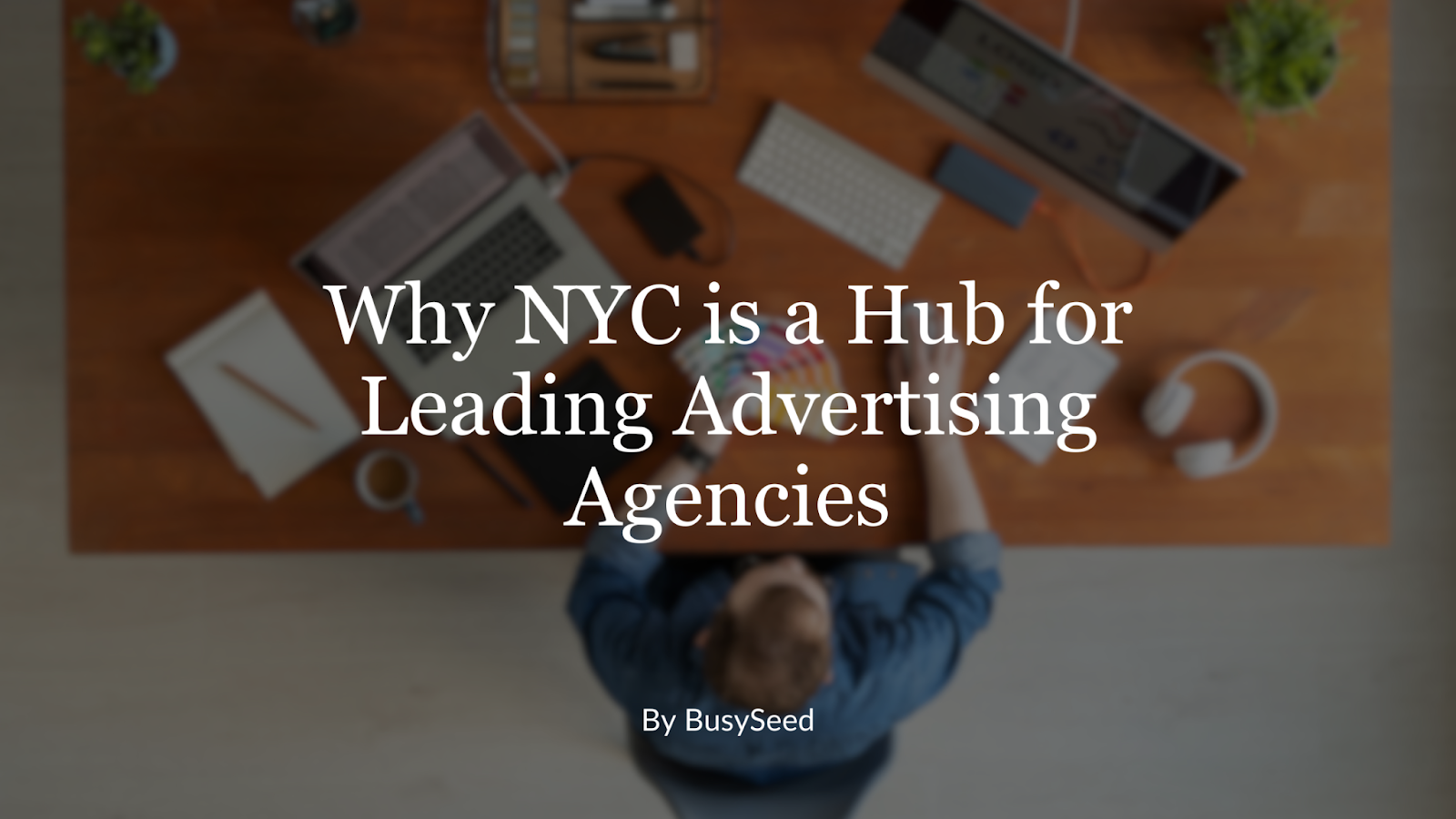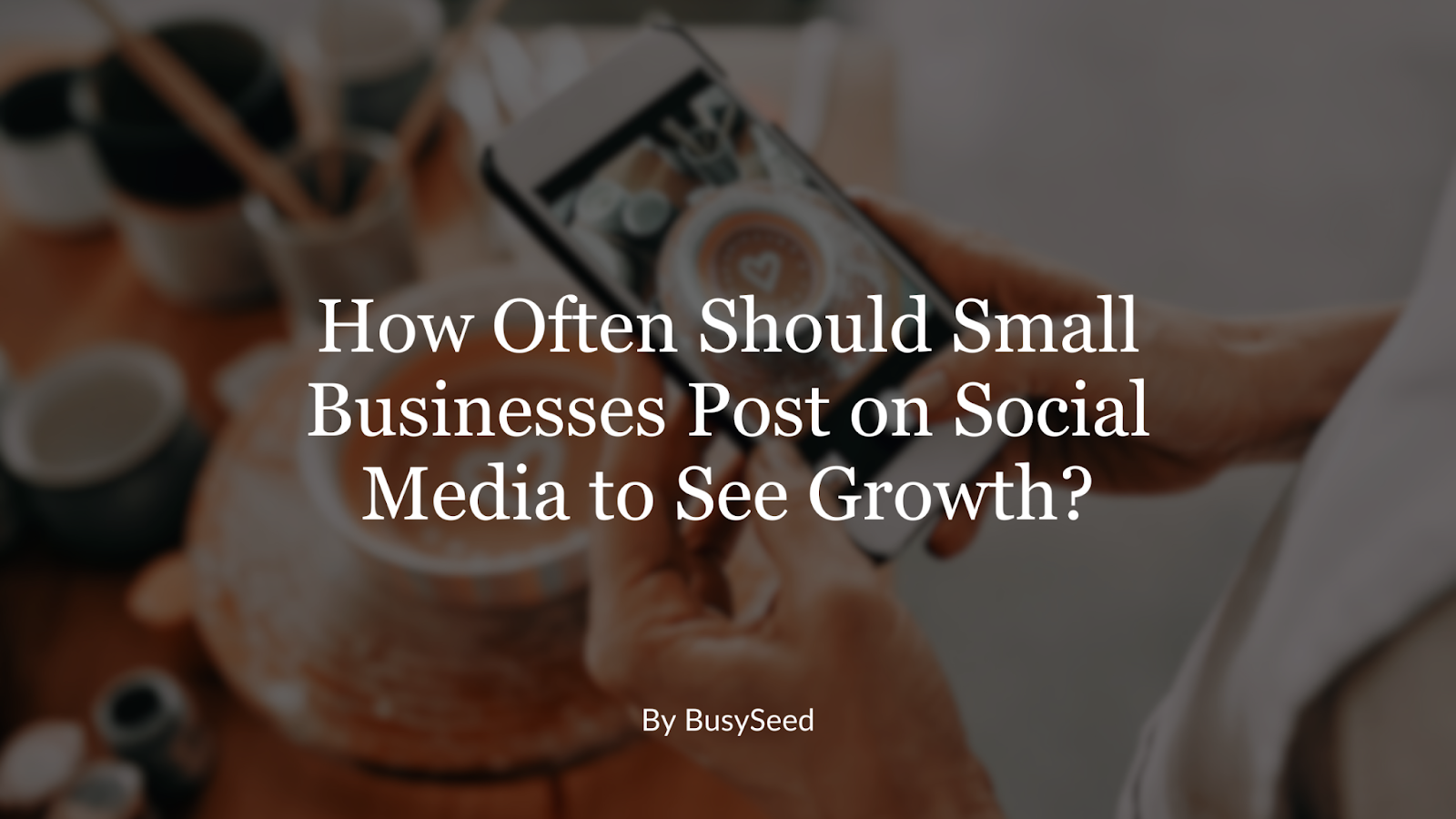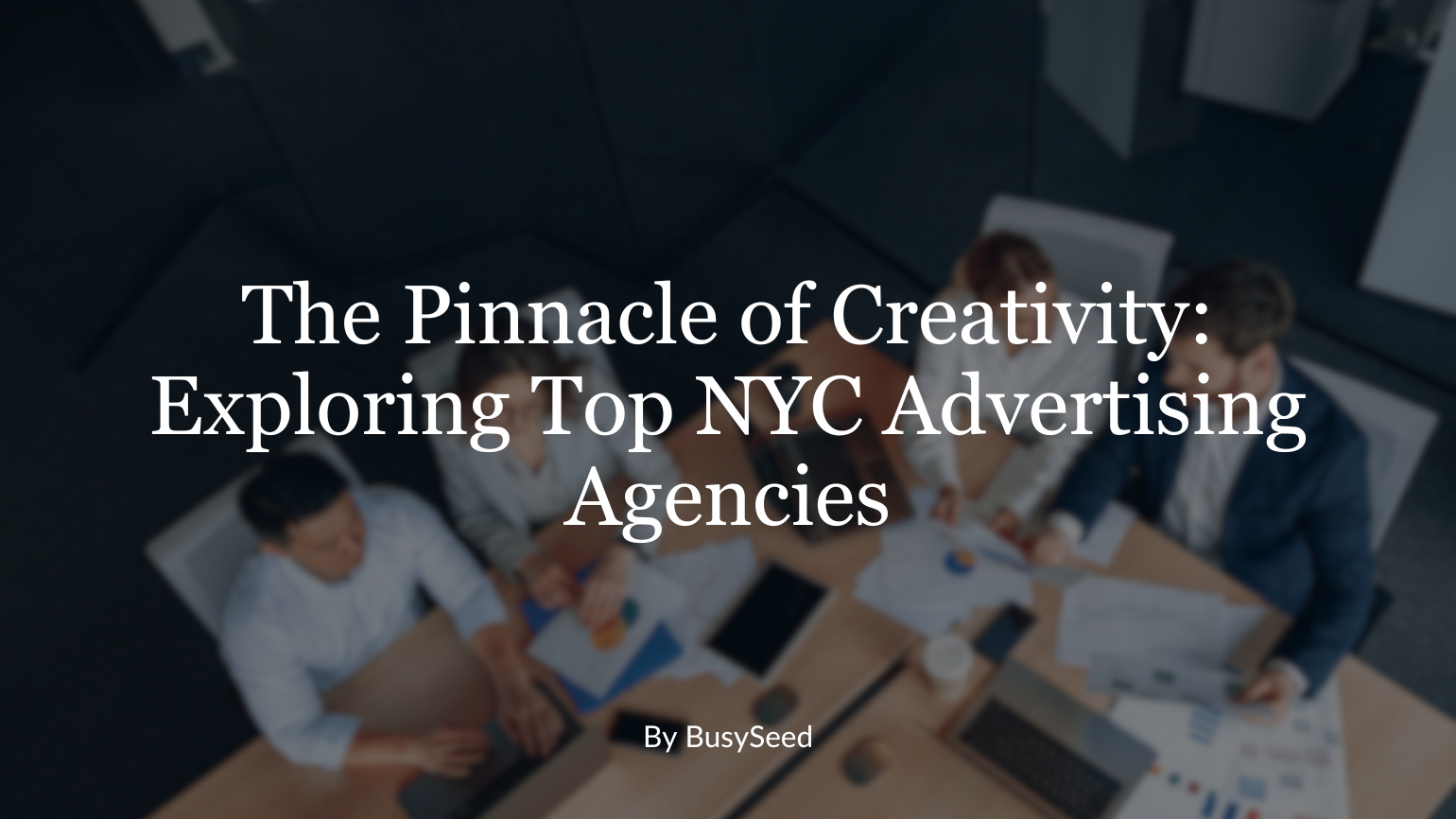10 Metrics to Track for Marketing ROI and Lead Conversion Success
Maximize your marketing ROI and boost lead conversion rates by tracking these 10 essential metrics. Learn from one of the
top ad agencies in NYC — BusySeed.
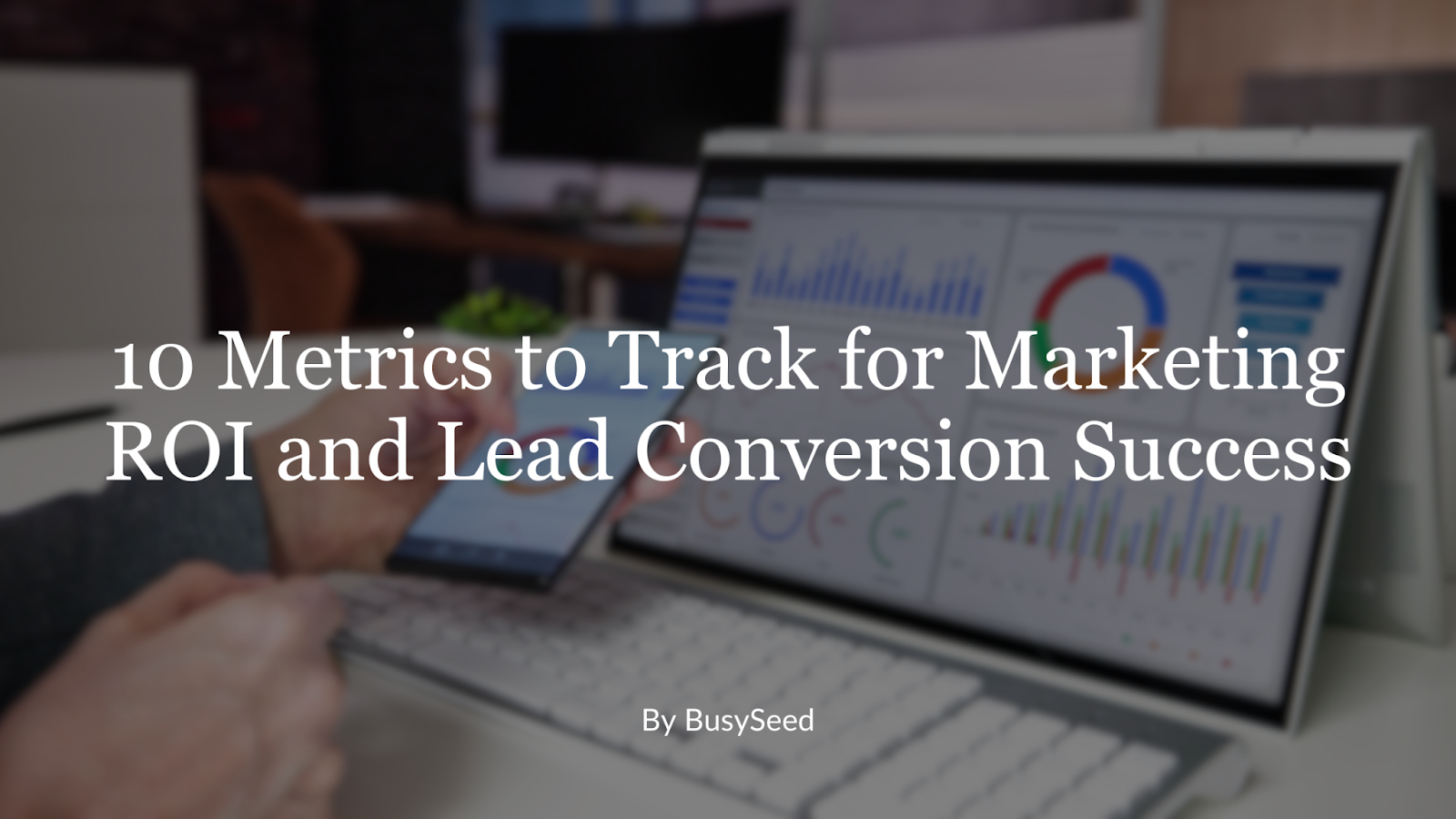
When it comes to marketing success, numbers tell the story. Whether you’re investing in digital campaigns or local lead generation tactics, tracking the right metrics is the difference between profitable growth and wasted budget. As one of the top ad agencies in NYC, we at BusySeed know that understanding your marketing ROI and lead conversion performance isn’t just a “nice-to-have”—it’s mandatory.
At BusySeed, we’re not just another face in the crowd of marketing companies NYC has to offer. We’re Growth Architects—strategic partners in designing, executing, and measuring marketing strategies that convert. Here, we’re pulling back the curtain and sharing the top 10 metrics every business should track if they’re serious about lead generation as a service and maximizing their marketing efforts.
Let’s dive in.
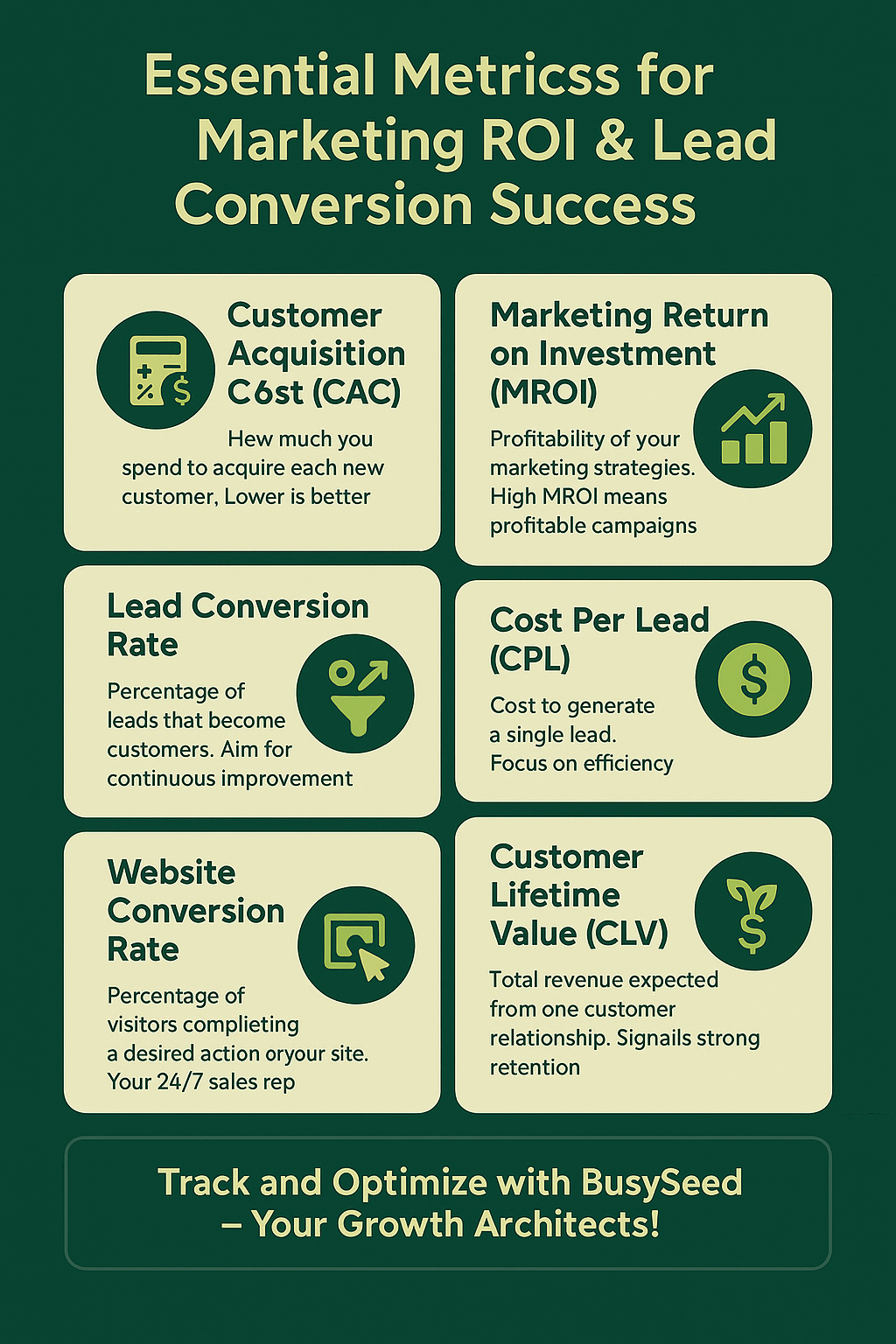
1. Customer Acquisition Cost (CAC)
What it is: Your total spend on sales and marketing divided by the number of new customers acquired.
Why it matters: CAC tells you how much you're spending to bring in each new customer. If your CAC is too high, it can eat into your profits—fast.
Example: If you spend $10,000 per month on sales and marketing and acquire 50 customers, your CAC is $200. Reducing CAC while maintaining conversion rates can drastically improve your marketing ROI.
BusySeed Insight: We've helped clients slash their CAC by up to 40% by refining audience targeting and automation workflows—something many advertising agencies NYC-wide overlook. Understanding and optimizing CAC is fundamental for sustainable growth, especially for businesses heavily invested in lead generation for companies of all sizes.
Deeper Dive into CAC: Beyond the Basics
While the basic formula for CAC is straightforward, a deeper analysis involves breaking it down by channel, campaign, or even customer segment. For instance, the CAC for customers acquired through paid search might be very different from those acquired through content marketing or local lead generation efforts. By pinpointing which channels are most cost-effective, you can strategically reallocate your marketing budget to maximize efficiency. This granular insight is a cornerstone of what sets top ad agencies in NYC like BusySeed apart. We also consider the sales cycle length and the resources invested at each stage to get a true picture of CAC.
2. Marketing Return on Investment (MROI)
What it is: (Revenue from marketing efforts - marketing costs) / marketing costs
Why it matters: This metric pinpoints the profitability of your marketing strategies and channels.
Too many marketing companies NYC brands turn to focus on clicks and impressions. But if those don't translate into dollars, they’re just vanity metrics. At BusySeed, we only call a campaign successful when it impacts revenue.
Actionable Tip: Track your MROI per channel to see where your marketing dollars stretch the furthest. A high MROI indicates that your marketing investments are generating significant returns, which is the ultimate goal of any effective lead generation as a service provider.
MROI: Connecting Marketing to the Bottom Line
MROI is perhaps the most critical metric for proving the value of marketing within an organization. It moves beyond simple engagement figures to show direct financial impact. For instance, if a campaign costs $5,000 but directly leads to $25,000 in new revenue, its MROI is 400%. This clear financial language helps marketing teams justify their budgets and demonstrates their contribution to overall business growth. This level of accountability is what clients expect from leading advertising agencies NYC provides.
3. Lead Conversion Rate
What it is: The percentage of leads that convert into customers.
Why it matters: If you're spending money on lead generation as a service but failing to convert those leads, you’re leaking cash.
Variation Example: A 3% to 5% jump in conversion rate can double your revenue without upping your lead spend.
BusySeed Case Study: One client saw a 70% increase in conversions after implementing our tailored lead nurturing sequences. This highlights just how critical proper tracking and testing are. Optimizing this rate is crucial for improving the efficiency of your lead generation for companies.
Optimizing Lead Conversion: The Nurturing Advantage
A high lead conversion rate is often the result of effective lead nurturing. Once a lead is acquired, whether through local lead generation or broader campaigns, the journey isn't over. Personalized email sequences, targeted content, and timely follow-ups can guide prospects through the sales funnel. BusySeed's expertise lies in crafting these nurturing pathways that address potential customer pain points and objections, ultimately accelerating their journey to becoming a paying customer. This meticulous approach is what defines superior marketing companies NYC.
4. Cost Per Lead (CPL)
What it is: Total marketing spend divided by the number of leads generated.
Why it matters: CPL breaks down how much you're spending to generate interest. It allows for budget refinement per channel or campaign.
Suggestion: Determine your acceptable CPL based on customer lifetime value (LTV), and aim for marketing efficiency over just lower costs. A low CPL indicates efficient lead generation for companies, but it must be balanced with lead quality.
CPL: Quality vs. Quantity
While a low CPL is generally desirable, it's vital to consider the quality of the leads generated. A low CPL for unqualified leads won't translate to a strong ROI. This is where the synergy between CPL and Lead Conversion Rate becomes apparent. The goal is to achieve an optimal balance where your CPL is manageable, and the leads generated have a high probability of conversion. This nuanced understanding is what separates effective advertising agencies NYC from those that simply focus on volume.
5. Marketing Qualified Leads (MQLs) vs. Sales Qualified Leads (SQLs)
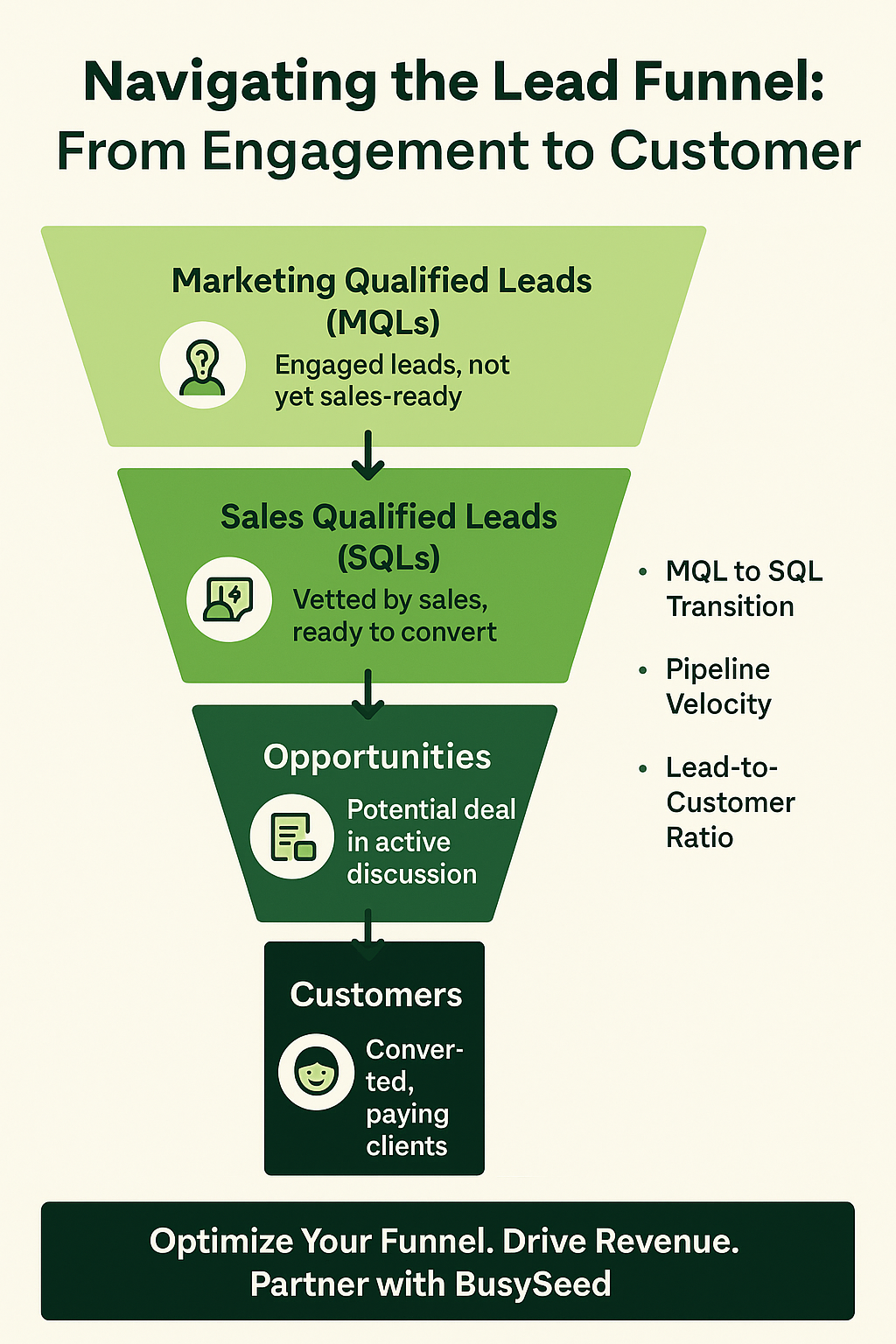
What it is:
- MQLs = Leads who have engaged but aren’t sales-ready.
- SQLs = Leads vetted by sales and ready to convert.
Why it matters: Not all leads are created equal. Tracking this split helps your team figure out where refinement is needed—whether in the messaging, lead gen funnel, or sales process.
BusySeed Strategy: We align sales and marketing efforts by creating a seamless funnel transition process. It’s this kind of synchronization that sets us apart from other advertising agencies NYC businesses rely on. This distinction is vital for successful lead generation as a service.
The MQL-SQL Hand-off: A Critical Junction
The hand-off between marketing and sales is often a point of friction. By clearly defining MQLs and SQLs, and establishing a rigorous process for their transition, businesses can significantly improve efficiency. Marketing focuses on nurturing MQLs until they meet specific criteria, at which point they are passed to sales as SQLs. This ensures sales teams are spending their valuable time on prospects who are genuinely ready to buy. This collaborative approach is a key strength offered by top ad agencies in NYC like BusySeed.
6. Pipeline Velocity
What it is: Measures how quickly leads move through the sales funnel.
Formula: (Number of Opportunities x Average Deal Size x Win Rate) / Sales Cycle Length
Why it matters: A slow pipeline can kill growth. If your velocity is lagging, it might be time to automate or rework your nurturing processes.
Pro Tip: This metric is especially vital for businesses investing in lead generation as a service to ensure qualified leads are capitalized on quickly. Improving pipeline velocity directly contributes to accelerated revenue generation for companies.
Accelerating the Sales Cycle
To improve pipeline velocity, consider identifying bottlenecks in your sales process. Are there stages where leads consistently get stuck? Could automation be introduced to streamline communication or follow-ups? Perhaps sales enablement content can be developed to address common objections earlier in the cycle. By proactively addressing these issues, businesses can reduce their sales cycle length and convert leads faster. This strategic optimization is a core focus for leading marketing companies NYC.
7. Website Conversion Rate
What it is: The percentage of website visitors who complete a desired action (form submission, phone call, download, etc.).
Why it matters: Your website is your 24/7 sales rep. If it isn’t converting, you’re losing money.
BusySeed Data Point: On average, we’ve increased our client website conversion rates by 62% through CRO (conversion rate optimization) tactics, smarter landing pages, and frictionless CTAs. This is a critical metric for any local lead generation strategy.
Website Optimization: Your Digital Sales Machine
A high website conversion rate is a testament to an effective online presence. This involves everything from clear navigation and compelling content to intuitive forms and strong calls to action. A/B testing different elements—like headlines, images, button colors, and form fields—can provide valuable insights into what resonates best with your audience. For businesses seeking effective lead generation for companies, the website is often the first and most crucial touchpoint.
8. Customer Lifetime Value (CLV)
What it is: The total revenue your business can reasonably expect from a single customer relationship.
Why it matters: Understanding CLV helps you determine how much you should invest in acquiring new customers and in retaining them.
Think Bigger: High CLV signals strong retention and customer success. Combine this with CAC to evaluate true profitability. For top ad agencies in NYC, CLV is a key indicator of long-term marketing success.
CLV: The Long-Term View of Profitability
While acquiring new customers is essential, retaining and growing existing ones is often more cost-effective. A strong CLV indicates that your products or services are valuable to customers over time, leading to repeat purchases, upsells, and referrals. By focusing on improving CLV, businesses can ensure sustainable growth and a more robust financial future. This metric underscores that effective lead generation as a service isn't just about the initial conversion, but the enduring relationship.
9. Email Open & Click-Through Rates
What it is: The percentage of recipients who open and click links in your marketing emails.
Why it matters: These micro-metrics show how effective your messaging and subject lines are.
Avoid the Trash Folder: A/B test your subject lines and offers to keep improving these KPIs. BusySeed deploys high-performing sequences that average 34% open rates—well above the industry average. These metrics are crucial for assessing the effectiveness of any local lead generation campaign that utilizes email.
Email Engagement: Beyond the Open
While open rates tell you if your subject line is compelling, click-through rates reveal whether your content is engaging and your calls to action are effective. Low click-through rates might indicate issues with email content relevance, design, or the clarity of your offer. Continuous A/B testing of various elements can provide valuable insights for optimizing these critical engagement metrics. For marketing companies NYC clients, strong email performance is a key driver of traffic and conversions.
10. Lead-to-Customer Ratio
What it is: The percentage of total leads that convert into actual paying customers.
Why it matters: This overarching metric connects all the dots. If local lead generation is strong but this ratio is weak, conversion tactics need work.
BusySeed's Recommendation: Use this metric to benchmark progress across quarters and identify where the most drop-offs occur in your sales funnel. This ultimate conversion metric is the proof point for effective lead generation for companies.
The Grand Finale: Lead-to-Customer Ratio
The Lead-to-Customer Ratio provides a holistic view of your entire marketing and sales funnel. It highlights the efficiency of your lead generation efforts in tandem with your sales team's ability to close deals. A low ratio, despite a high volume of leads, points to inefficiencies in nurturing, qualification, or sales execution. By analyzing this metric in conjunction with others, businesses can identify specific areas for improvement, ensuring that every lead has the best possible chance of becoming a loyal customer. This holistic analytical approach is a core offering of premier advertising agencies NYC.
A Smarter Way to Measure Marketing
These 10 marketing and sales metrics are more than just numbers—they’re levers you can pull to affect real, bottom-line change. Whether you’re experimenting with new Facebook ad campaigns or investing in lead generation for companies like yours, tracking and optimizing these KPIs will accelerate your growth.
Remember, most marketing companies NYC business owners work with stop at surface-level metrics. BusySeed goes deeper. As one of the leading advertising agencies NYC has to offer, we act as an extension of your team—focused squarely on driving revenue, not fluff.
Let’s revisit why these metrics matter:
- Improve budgeting decisions
- Accelerate lead conversion
- Reduce unnecessary spend
- Boost customer value
- Align marketing with actual sales
Call to Action
Ready to confidently track and tackle these 10 metrics for better marketing ROI and smarter lead conversion?
Schedule a free consultation to discuss 10 Metrics to Track for Marketing ROI and Lead Conversion Success with a member of our expert team.
Still exploring? Dive into related resources:
- Our Lead Generation Services:
https://www.busyseed.com/services/lead-generation - Digital Marketing Expertise:
https://www.busyseed.com/services/digital-marketing - Sales Enablement Strategies:
https://www.busyseed.com/services/sales-enablement
At BusySeed, we’re about more than impressions. We’re about impact. And that begins with knowing what to measure—and how to use it to your advantage.
Let’s build your funnel, drive your revenue, and grow your brand—together.
FAQ
Q1: Why is tracking marketing ROI so important?
A1: Tracking marketing ROI (MROI) is crucial because it directly measures the profitability of your marketing strategies and channels. Unlike vanity metrics like clicks or impressions, MROI shows how your marketing efforts translate into actual revenue, allowing you to identify what works and optimize your budget for maximum financial impact. This is a key focus for top ad agencies in NYC like BusySeed.
Q2: What's the difference between MQLs and SQLs, and why should I track them?
A2: MQLs (Marketing Qualified Leads) are leads who have engaged with your marketing but aren't yet sales-ready, while SQLs (Sales Qualified Leads) have been vetted by sales and are ready to convert. Tracking this distinction helps identify where refinement is needed in your messaging, lead generation funnel, or sales process. It also ensures a seamless transition of qualified leads from marketing to sales, which is vital for efficient lead generation as a service.
Q3: How can I improve my Lead Conversion Rate?
A3: Improving your Lead Conversion Rate involves optimizing various aspects of your marketing and sales funnel. This includes refining audience targeting, implementing tailored lead nurturing sequences, ensuring your website is optimized for conversion with clear CTAs, and aligning sales and marketing efforts for a seamless lead hand-off. BusySeed has helped clients significantly increase conversions through these strategies. For effective lead generation for companies, a strong conversion rate is paramount.
Q4: Why is Customer Lifetime Value (CLV) important even if my main focus is lead generation?
A4: While local lead generation is about acquiring new customers, CLV is crucial because it tells you the total revenue your business can expect from a single customer relationship over time. Understanding CLV helps determine how much you should invest in customer acquisition and retention, evaluating true long-term profitability. A high CLV indicates strong customer retention and overall business health, which influences how much you can profitably spend to acquire new leads.
Q5: What makes BusySeed different from other marketing companies NYC?
A5: BusySeed distinguishes itself by acting as Growth Architects, focusing squarely on driving revenue rather than just surface-level metrics. As one of the leading
advertising agencies NYC, we provide strategic partnership, deep analytics, and a proven ability to reduce CAC and increase conversion rates through refined targeting, automation, and seamless sales-marketing alignment. We are committed to delivering measurable impact and long-term business success for our clients.
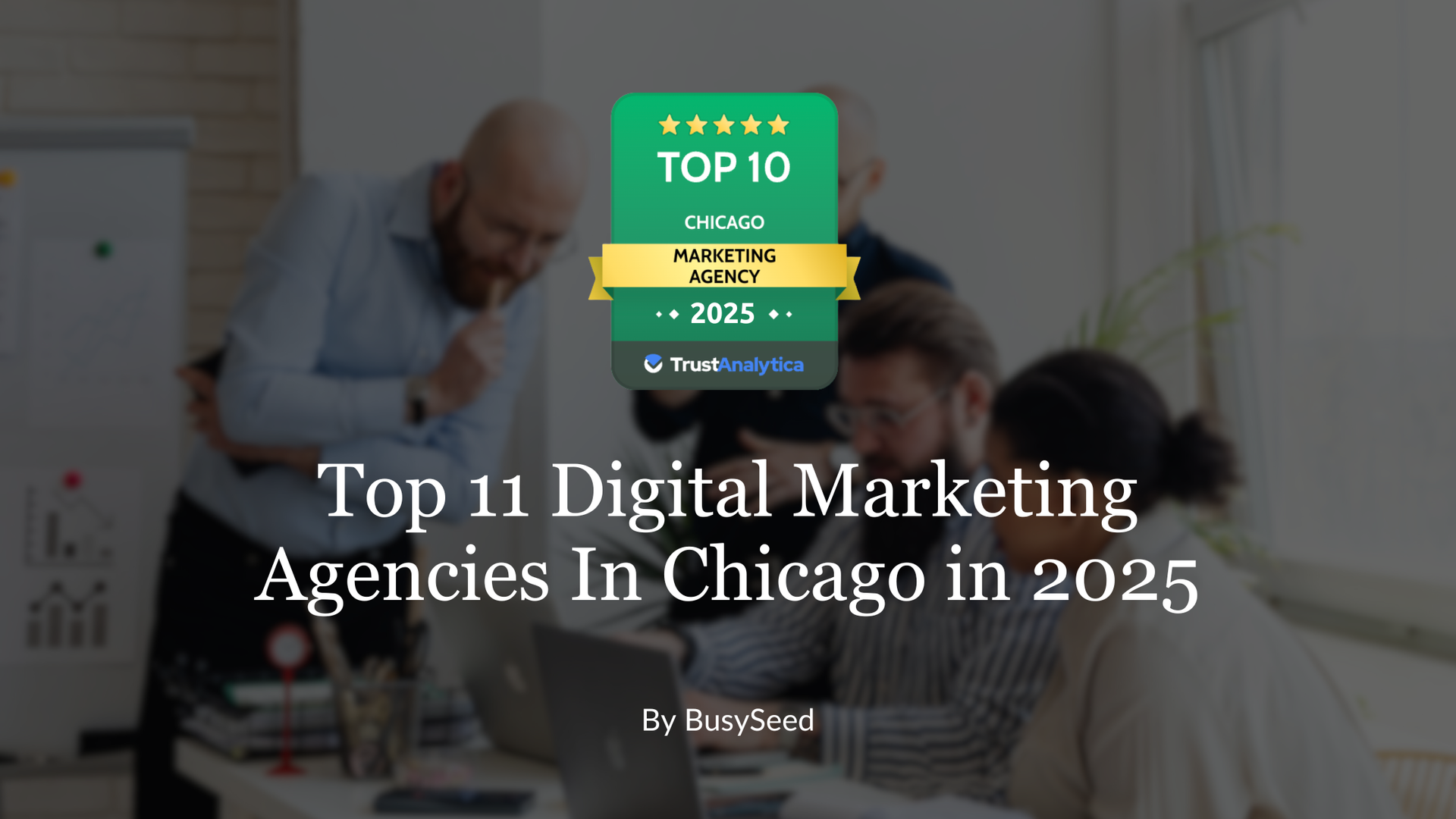
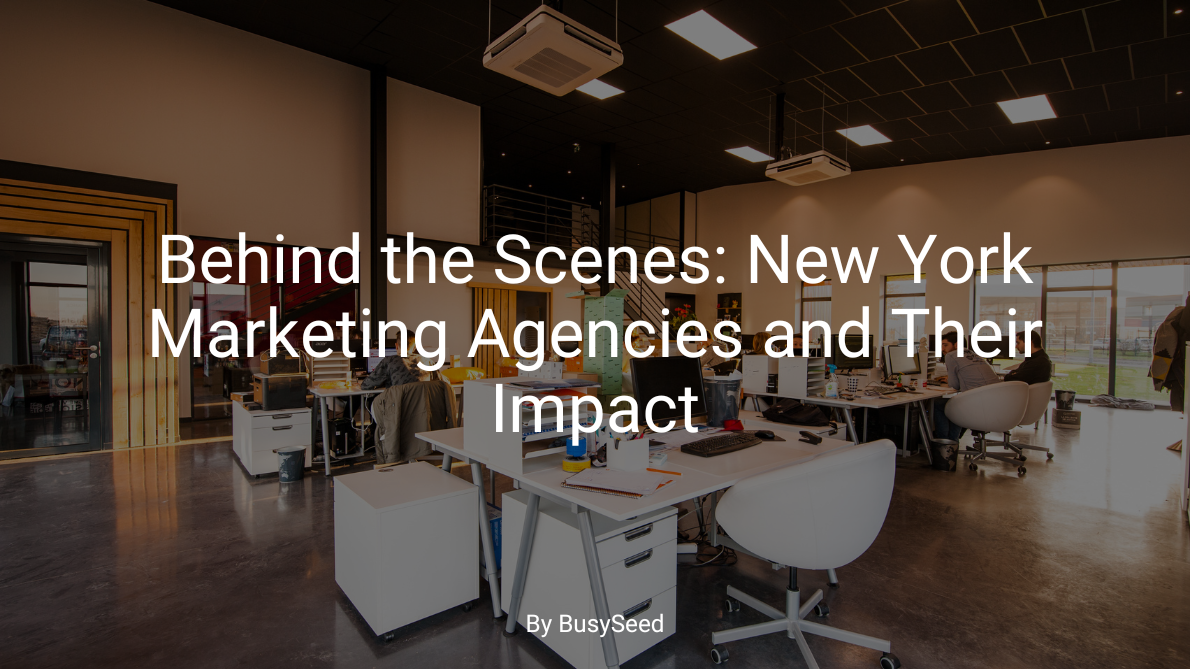

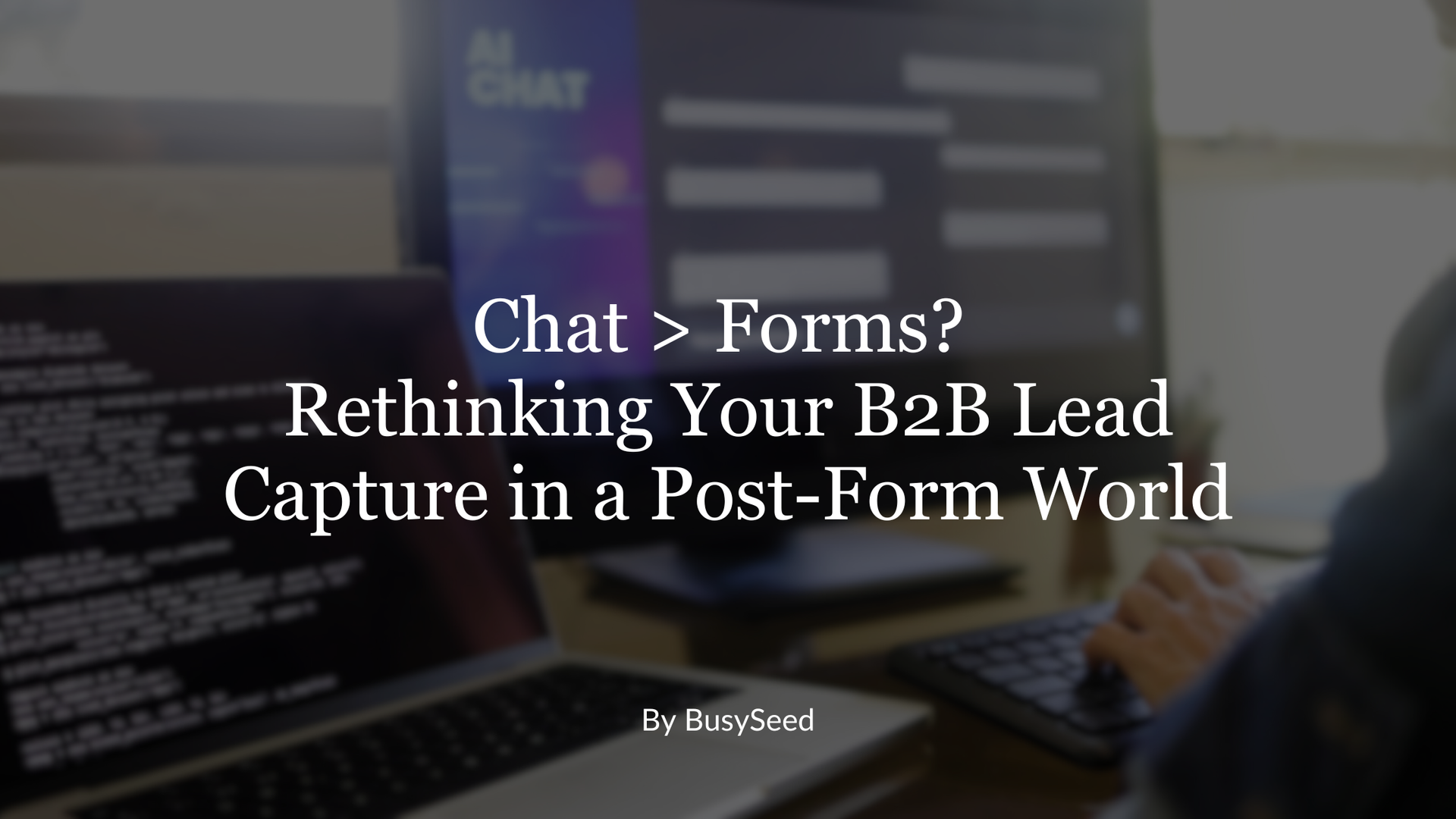 Forms? Rethinking Your B2B Lead Capture in a Post-Form World"." onerror="handleImageLoadError(this)"/>
Forms? Rethinking Your B2B Lead Capture in a Post-Form World"." onerror="handleImageLoadError(this)"/>